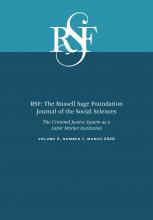Research Article
Open Access
Institutional Castling: Military Enlistment and Mass Incarceration in the United States
Bryan L. Sykes, Amy Kate Bailey
RSF: The Russell Sage Foundation Journal of the Social Sciences March 2020, 6 (1) 30-54; DOI: https://doi.org/10.7758/RSF.2020.6.1.02
Bryan L. Sykes
aAssistant professor in the Department of Criminology, Law and Society and Sociology and Public Health, by courtesy, at the University of California, Irvine
Amy Kate Bailey
bAssociate professor in the Department of Sociology at the University of Illinois–Chicago and visiting faculty affiliate at the University of Washington’s Center for Studies in Demography and Ecology

REFERENCES
- ↵
- Alexander, Michelle
- ↵
- Angrist, Joshua D
- ↵
- Angrist, Joshua D., and
- Alan B. Kreuger
- ↵
- Apel, Robert, and
- Julie Horney
- ↵
- Appy, Christian G
- ↵
- Asch, Beth J.,
- James R. Hosek, and
- John T. Warner
- ↵
- Asch, Beth J.,
- Trey Miller, and
- Alessandro Malchiodi
- ↵
- Autor, David H., and
- Mark G. Duggan
- ↵
- Bachman, Jerald G.,
- Peter Freedman-Doan, and
- Patrick M. O’Malley
- ↵
- Bailey, Amy Kate, and
- Bryan L. Sykes
- ↵
- Barley, Stephen R
- ↵
- ↵
- Boesel, David
- ↵
- Bouffard, Leana Allen
- ↵
- ↵
- ↵
- Cantor, David, and
- Kenneth C. Land
- ↵
- Carnevale, Anthony P.,
- Nicole Smith, and
- Jeff Strohl
- ↵
- Crutchfield, Robert D
- ↵
- Crutchfield, Robert D
- ↵
- Crutchfield, Robert D., and
- Susan R. Pitchford
- ↵
- Culp, Richard,
- Tasha Youstin,
- Kristin Englander, and
- James Lynch
- ↵
- Day, Jennifer Cheeseman, and
- Kurt J. Bauman
- ↵
- Defense Manpower Data Center (DMDC)
- ↵
- Doeringer, Peter B., and
- Michael J. Piore
- ↵
- Dressler, David
- ↵
- Du Bois, W.E.B
- ↵
- Elder, Glenn, Jr.
- ↵
- Elder, Glenn, Jr.
- ↵
- Elder, Glenn, Jr.
- ↵
- Erickson, Steven,
- Robert Rosenheck,
- Robert Trestman,
- Julian Ford, and
- Rani Desai
- ↵
- ↵
- Fernandez, Richard L
- ↵
- Fredland, J. Eric,
- Curtis L. Gilroy,
- Roger D. Little, and
- W. S. Sellman
- ↵
- ↵
- Garland, David
- ↵
- ↵
- Glaze, Lauren, and
- Danielle Kaeble
- ↵
- Greenberg, Greg, and
- Robert Rosenheck
- ↵
- Greenberg, Greg, and
- Robert Rosenheck
- ↵
- Grissmer, David W
- ↵
- Gupta, Sanjiv, and
- Jennifer Hickes Lundquist
- ↵
- Gustafson, Kaaryn
- ↵
- Han, JooHee
- ↵
- Harcourt, Bernard
- ↵
- Harcourt, Bernard
- ↵
- Harcourt, Bernard
- ↵
- ↵
- Hinton, Elizabeth
- ↵
- Holzer, Harry J.,
- Paul Offner, and
- Elaine Sorenson
- ↵
- Houle, Jason N
- ↵
- Kilburn, M. Rebecca,
- Lawrence M. Hanser, and
- Jacob Alex Klerman
- ↵
- Kitagawa, Evelyn M
- ↵
- ↵
- Lundquist, Jennifer Hickes,
- Devah Pager, and
- Eiko Strader
- ↵
- Lytell, Maria C.,
- Kenneth Kuhn,
- Abigail Haddad,
- Jefferson P. Marquis,
- Nelson Lim,
- Kimberly Curry Hall,
- Robert Stewart, and
- Jennie W. Wenger
- ↵
- MacLean, Alair, and
- Nicholas L. Parsons
- ↵
- Mare, Robert D., and
- Christopher Winship
- ↵
- Mattick, Hans
- ↵
- Mitchell, John
- ↵
- Morin, Rich
- ↵
- Moskos, Charles, and
- John Sibley Butler
- ↵
- Nalty, Bernard C
- ↵
- Neal, Derek, and
- Armin Rick
- ↵
- Nixon, Richard
- ↵
- Office of the Deputy Assistant Secretary of Defense, Military Community and Family Policy
- ↵
- Office of Justice Programs
- ↵
- Office of the Under Secretary of Defense, Personnel and Readiness
- ↵
- Office of the Under Secretary for Personnel and Readiness
- ↵
- Oi, Walter Y
- ↵
- Pettit, Becky
- ↵
- Pettit, Becky, and
- Bryan L. Sykes
- ↵
- Pettit, Becky,
- Bryan L. Sykes, and
- Bruce Western
- ↵
- Pettit, Becky, and
- Bruce Western
- ↵
- ↵
- Preston, Samuel,
- Patrick Heuveline, and
- Michel Guillot
- ↵
- Roediger, David
- ↵
- Sampson, Robert J., and
- John H. Laub
- ↵
- Sampson, Robert J., and
- John H. Laub
- ↵
- Segal David R., and
- Mady Wechsler Segal
- ↵
- Shannon, Sarah,
- Christopher Uggen,
- Jason Schnittker,
- Melissa Thompson,
- Sara Wakefield, and
- Michael Massoglia
- ↵
- Shattuck, Edward
- ↵
- Simon, Jonathan
- ↵
- ↵
- Steele, Jennifer L.,
- Nicholas Salcedo, and
- James Coley
- ↵
- Sutton, John R
- ↵
- ↵
- ↵
- Tanielian, Terri, and
- Lisa H. Jaycox
- ↵
- Teachman, Jay,
- Vaughan Call, and
- Mady Wechsler Segal
- ↵
- Teachman, Jay, and
- Lucky Tedrow
- ↵
- Thirtle, Michael R
- ↵
- Travis, Jeremy,
- Bruce Western, and
- Steve Redburn
- ↵
- ↵
- Turney, Kristin, and
- Emma Conner
- ↵
- ↵
- Uggen, Christopher
- ↵
- U.S. Congress
- ↵
- ↵
- ↵
- Wacquant, Loïc
- ↵
- ↵
- Wadsworth, Tim
- ↵
- West, Heather C., and
- William J. Sabol
- ↵
- Western, Bruce
- ↵
- Western, Bruce
- ↵
- ↵
- ↵
- ↵
- Wilson, William Julius
In this issue
Institutional Castling: Military Enlistment and Mass Incarceration in the United States
Bryan L. Sykes, Amy Kate Bailey
RSF: The Russell Sage Foundation Journal of the Social Sciences Mar 2020, 6 (1) 30-54; DOI: 10.7758/RSF.2020.6.1.02
Jump to section
Related Articles
- No related articles found.
Cited By...
- No citing articles found.





